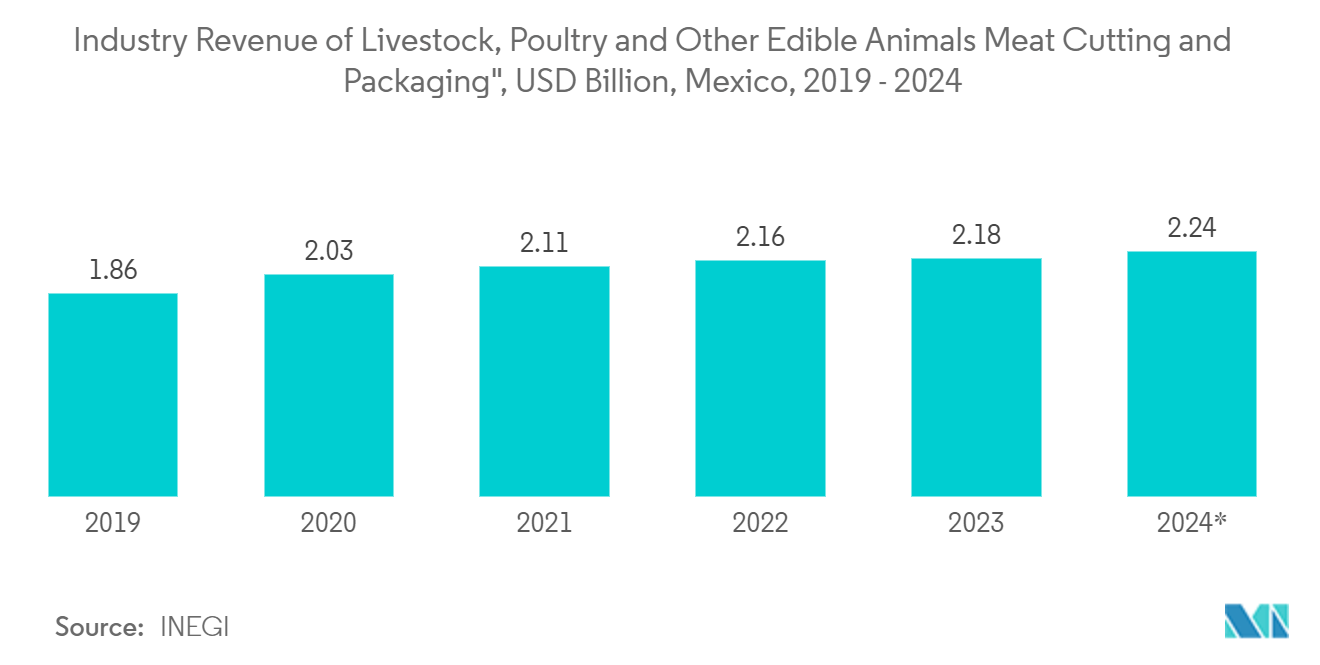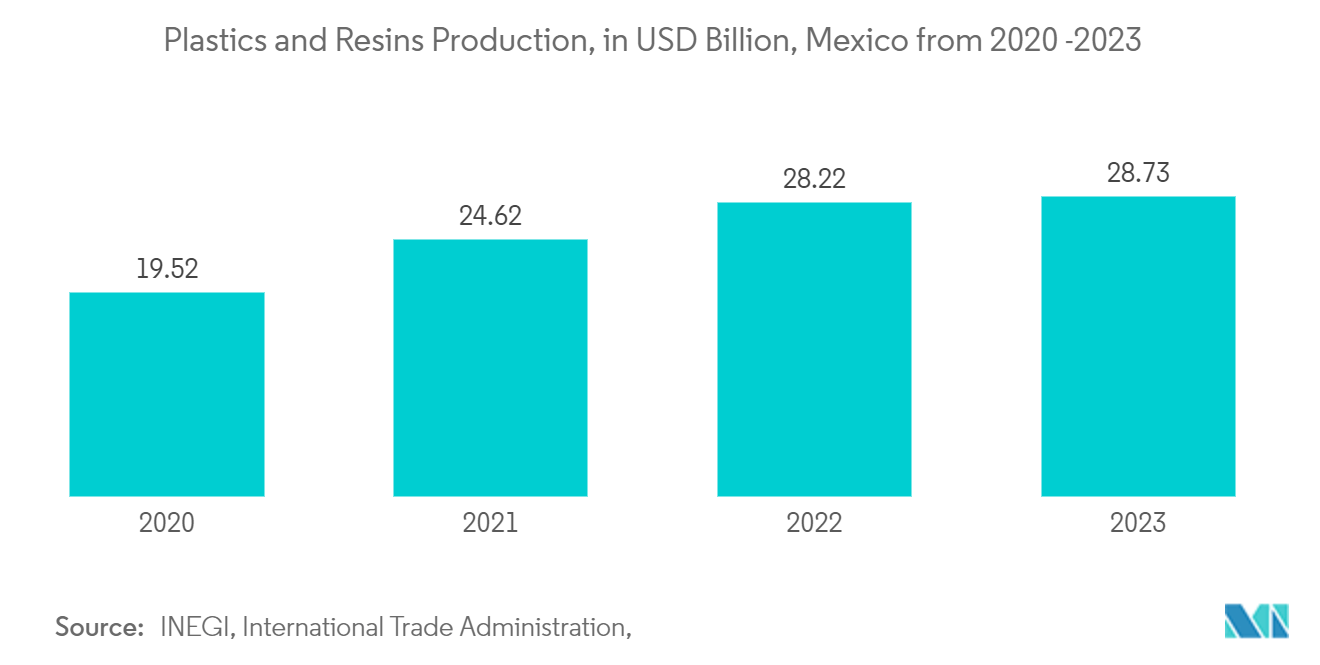Market Trends of Mexico Plastic Packaging Films Industry
Increasing Demand for Plastic Films Across End user Industries
- Plastic film packaging, encompassing pouches, bags, films, and wraps, caters to the varied needs of the meat, poultry, and fish sectors. Its adaptability allows for packaging a range of cuts and portion sizes, from whole pieces to processed products like sausages and fillets. Moreover, this packaging type extends shelf life, enhances product visibility, and shields against contamination and spoilage, making it highly favored by both producers and consumers.
- In recent years, Mexico has significantly increased beef, pork, poultry, and seafood consumption and production. This growth is driven by a growing need for packaging that appeals to consumers and safeguards the products. As a result, packaging for meat, poultry, and seafood has emerged as a cost-efficient and practical choice. Projections indicate a surge in sales of plastic packaging in the upcoming years. This rise is mainly due to an increased focus on hygiene and the demand for packaging that extends shelf life and preserves the essential characteristics of meat and poultry, which are vital for both local and international markets.
- According to a recent USDA's Global Agricultural Information Network (GAIN) report, Mexico's appetite for chicken meat is rising. This trend is primarily attributed to the competitive pricing of chicken compared to other meats, coupled with an uptick in household incomes. Notably, Mexico stands as the world's fifth-largest consumer of chicken meat, with a persistent upward trajectory in demand. Chicken meat reigns as the most favored animal protein in the country. Projections indicate that in 2024, consumption is set to hit 4.9 million metric tons (MMT), marking a 3% increase from 2023's 4.8 MMT. The growth in per capita consumption is expected to be notably stronger in 2024, primarily fueled by a heightened demand for processed chicken products like cold cuts and frozen breaded varieties.
- In 2023, Mexico's revenue for the "Livestock, Poultry, and Other Edible Animals Meat Cutting and Packaging" industry rose to USD 2.18 billion, up from USD 2.6 billion. Projections indicate this figure will further climb to USD 2.24 billion by 2024.
- This uptick in demand is shifting towards adopting specialized plastic films for meat packaging, enhancing freshness during transit. These films act as a protective shield, safeguarding the meat from contaminants and elongating its shelf life. These films have become indispensable because they preserve quality during transportation and storage. Moreover, the escalating export value mirrors a surging global interest in Spanish poultry products. Consequently, there's a heightened need for packaging technologies to align with international standards and consumer preferences.

Polythene Segment Expected to Hold Significant Share in the Market
- Polyethylene (PE) has taken the forefront among plastic materials in Mexico, prized for its versatile physical properties. Its cost-effective production sets it apart from other plastics. Notably, PE boasts the lowest softening point among primary packaging plastics, reducing energy consumption. LDPE and LLDPE, closely related to PE, are prevalent in flexible packaging. Widely employed in the creation of plastic bags, films, and geomembranes, polyethylene's appeal lies in its lightweight nature, partial crystallinity, and notable features such as chemical resistance, low moisture absorption, and sound insulation.
- Given its diverse applications across sectors, Mexico's plastics market is a lucrative prospect for US exporters. Plastic products and resins are Mexico's top two US export categories. Mexico is the primary destination for US plastics, processing machinery, and related equipment. Since 2018, Mexico's plastics production has consistently grown, averaging 5.27% annually. In 2022, Mexico faced resin shortages, attributed to a slowdown in primary industries, yet managed to meet a surge in customer orders, resulting in a 13% increase in plastic production from the previous year. Mexico's total plastics imports in 2022 amounted to USD 41.52 billion, with the US accounting for a significant share, totaling USD 22.6 billion, representing 61% of Mexico's imports.
- Polyethylene, known for its flexibility, high moisture resistance, and durability, excels even in low temperatures. A key advantage is its natural sealing ability, often eliminating the need for additional coatings. Polyethylene forms a robust barrier when used alone or in combination with other materials. Its eco-friendly nature particularly appeals to packaging film manufacturers, aligning well with growing sustainability priorities.
- In 2023, Mexico's plastics and resins production reached a valuation of USD 28.73 billion. This growth was fueled by a surge in nearshoring, bolstered by fresh orders from the US and Canada, primarily attributed to the USMCA. The industry is witnessing a push toward sustainability, focusing on recycling technologies and the development of bioplastics to address global environmental concerns. US involvement in selling capital equipment, resins, plastic materials, parts, and molds remains a lucrative opportunity for Mexican producers.
- Mexico leads Latin America in polyethylene terephthalate (PET) recycling, boasting a 59% recovery rate for PET bottles designated for recycling. With nearly two million tons of plastic recycled annually, this high recycling rate makes Mexico less attractive for foreign PET sales, as local sourcing proves more cost-effective. Many major Mexican companies use in-house recycling to meet stringent health and environmental regulations. Given this, there's a growing demand anticipated for advanced plastic recycling technologies and high-purity recycled materials in the coming years.


